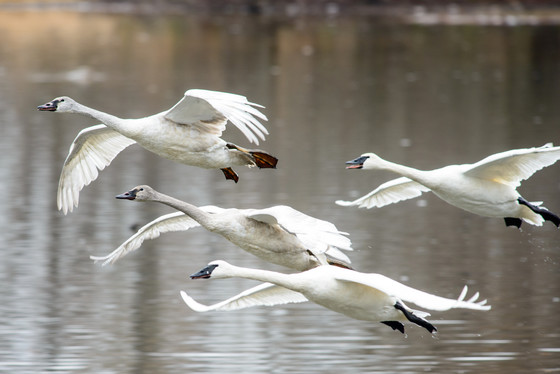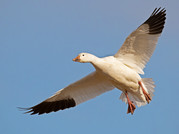Contact: Sumner Matteson, DNR Avian Ecologist
Sumner.Matteson@wisconsin.gov or 608-225-0586
Taylor Finger, DNR Wildlife Biologist
Taylor.Finger@wisconsin.gov or 608-266-8841
Joanne Haas, DNR Law Enforcement Spokeswoman
Joanne.Haas@wisconsin.gov or 608-209-8147
Waterfowl Hunters Reminded It’s Illegal To Shoot Trumpeter Swans And Other Protected Big White Birds
Know the difference between protected swans and legally hunted species
 A family of trumpeter swans flies over water. Be sure of your targets while waterfowl hunting.
Photo credit: iStock/erniedecker, photosbyjimn, BrianEKushner
A family of trumpeter swans flies over water. Be sure of your targets while waterfowl hunting.
Photo credit: iStock/erniedecker, photosbyjimn, BrianEKushner
MADISON, Wis. – After the illegal shooting of a protected trumpeter swan near Hudson earlier this month, the Wisconsin Department of Natural Resources (DNR) reminds hunters to be sure of their targets before firing overhead.
With the waterfowl season underway and goose season open through early January, it’s critical for hunters to know the difference between waterfowl species legal to hunt and other big white birds that are not legal to hunt in Wisconsin.
All wild swans are protected in Wisconsin. It is illegal to hunt native trumpeter swans, tundra swans and non-native mute swans in Wisconsin. Other large white birds, including American white pelicans and whooping cranes, are also illegal to hunt.
“Know your target before going out into the field,” said Sumner Matteson, an avian ecologist for the DNR’s Natural Heritage Conservation Program who led the agency’s efforts to help restore trumpeter swans in Wisconsin. “Once you’re out hunting, be patient and make certain you know what your target is as it’s flying.”
Many of these species are more abundant and widespread in Wisconsin so hunters may be encountering them more frequently. The once-endangered trumpeter swan now exceeds 6,000 in number since their successful reintroduction by the DNR and partners starting in the late 1980s, a story highlighted in the Wisconsin Natural Resources magazine article “Cygnus Buccinator: A comeback for the ages.”
The St. Croix River's open water attracts swans in the Hudson area where the illegal trumpeter swan shooting occurred, Matteson said. In some other state waters, rising temperatures from climate change keep the water from freezing longer, resulting in an increasing number of birds overwintering in Wisconsin.
Hunters are also reminded to keep COVID-19 safety measures in mind when out in the field. As Wisconsin continues to see record-setting numbers of positive cases of COVID-19, health and safety is paramount.
On Nov. 10, Gov. Tony Evers issued Executive Order #94 outlining new measures to help stop the spread of COVID-19. This order advises Wisconsinites to stay home, use extra precautions if they must leave their home and adopt good public health practices. Businesses are also encouraged to take further steps to protect workers, customers and the surrounding community.
How to tell Wisconsin’s protected swans from other large white birds

Trumpeter swans (pictured at right) are North America’s largest native waterfowl species at 4.5 to 5 feet long, and weighing 20 to 30 pounds with a wingspan over 7 feet, according to Taylor Finger, DNR migratory game bird ecologist.
Tundra swans are slightly smaller and are best distinguished by their high-pitched quavering call, unlike the deep, trumpet-like call of the trumpeter swan.
Nonnative mute swans are similarly sized to both native swans but can be distinguished by its orange bill – both native swans have black bills – and prominent black fleshy knob extending from the base of the bill to the forehead.

Legally hunted across the state, snow geese (pictured at right) are significantly smaller than Wisconsin's swan species. Snow geese are 2 feet long, 5 to 6 pounds, and have a wingspan of 4.5 feet. If hunters are having trouble judging the bird's relative size from the ground, snow geese also have pink bills and black tips visible on the underside of their wings during flight.
“We have good numbers of trumpeter swans and tens of thousands of tundra swans on the Mississippi River, said Finger. "Snow geese are infrequent visitors to Wisconsin, while the native swans are much more abundant. I encourage hunters to visit these sites where these birds congregate and educate themselves.”
Don't shoot a swan!
Shooting a swan may cost you up to $2,327 in penalties and a 3-year revocation of all hunting, fishing and trapping privileges. Also protected are American white pelicans and whooping cranes, two more large white birds with contrasting black wing tips.
Hunters mistaking a swan or other protected species for a legally huntable species face penalties, as three men did after shooting at trumpeter swans on Lake Mallalieu in St. Croix County in early November.
Alerted by citizens to the shooting, DNR Conservation Warden Paul Sickman retrieved one dead swan and cited three hunters for Take/Attempt to Take a Protected Species, which carries a $303.30 penalty. One hunter also received a citation for $175 in restitution for the swan.
"Be sure of your target before you shoot," said Sickman, adding that the hunters were all cooperative, apologetic and learned their lesson. "The safest thing to do is don't shoot if you don't know what kind of bird it is."
For more information about trumpeter swan identification, photos and tips for how to tell trumpeter swans apart from other large white birds visit the DNR’s Swans in Wisconsin webpage and The Trumpeter Swan Society’s website.

